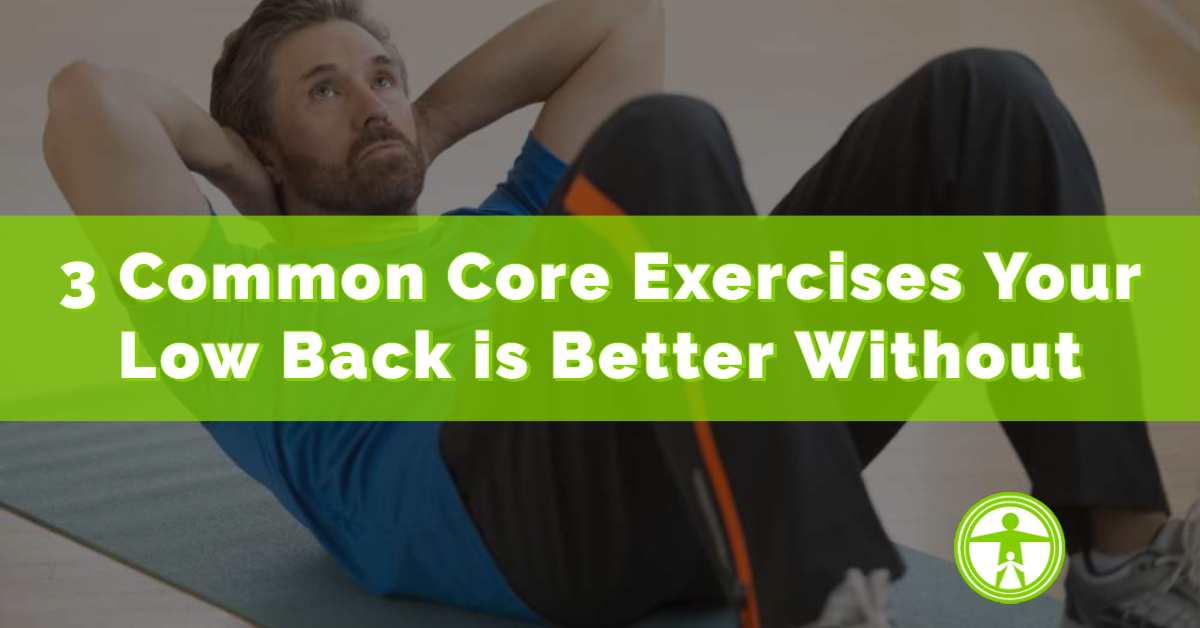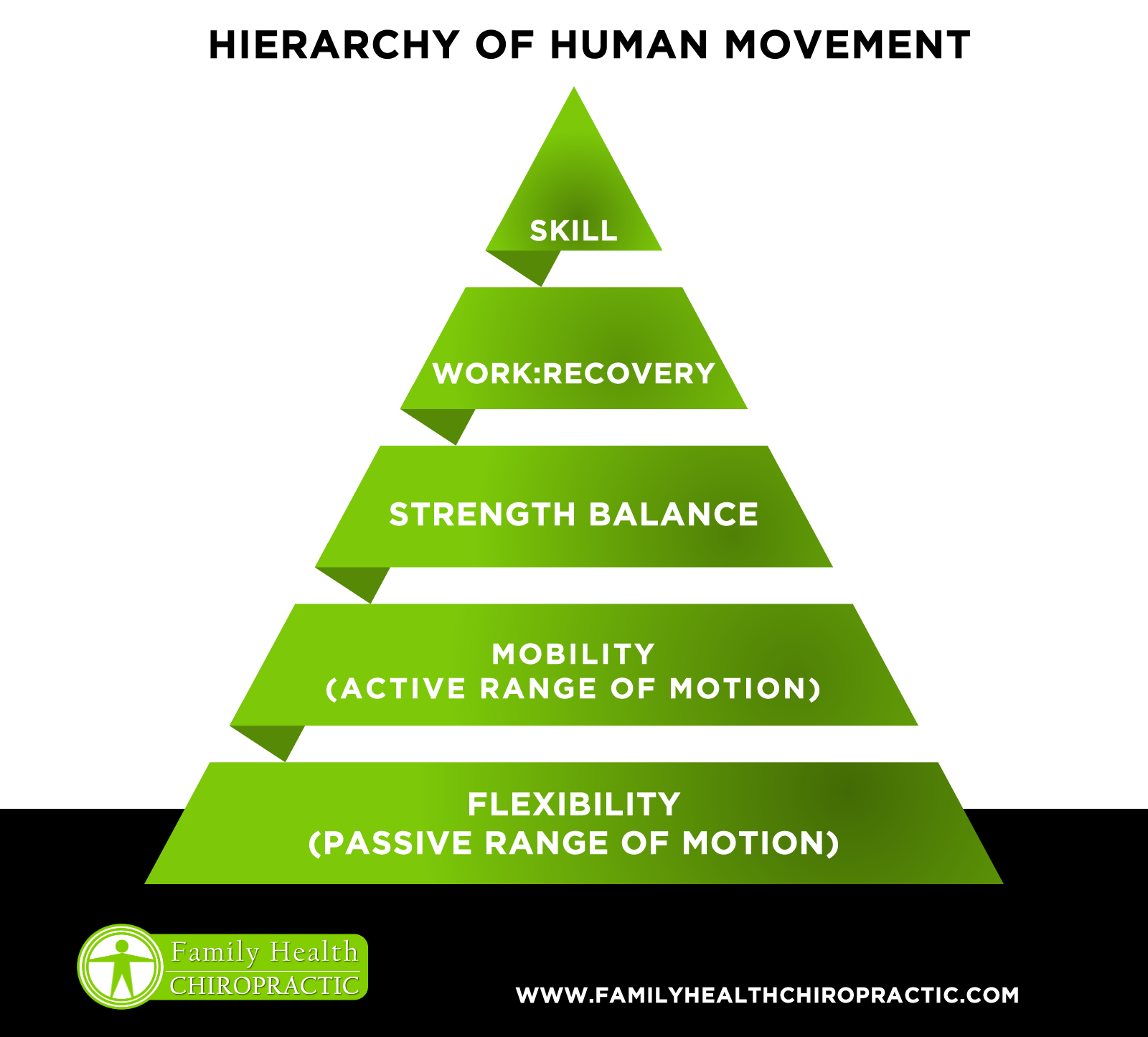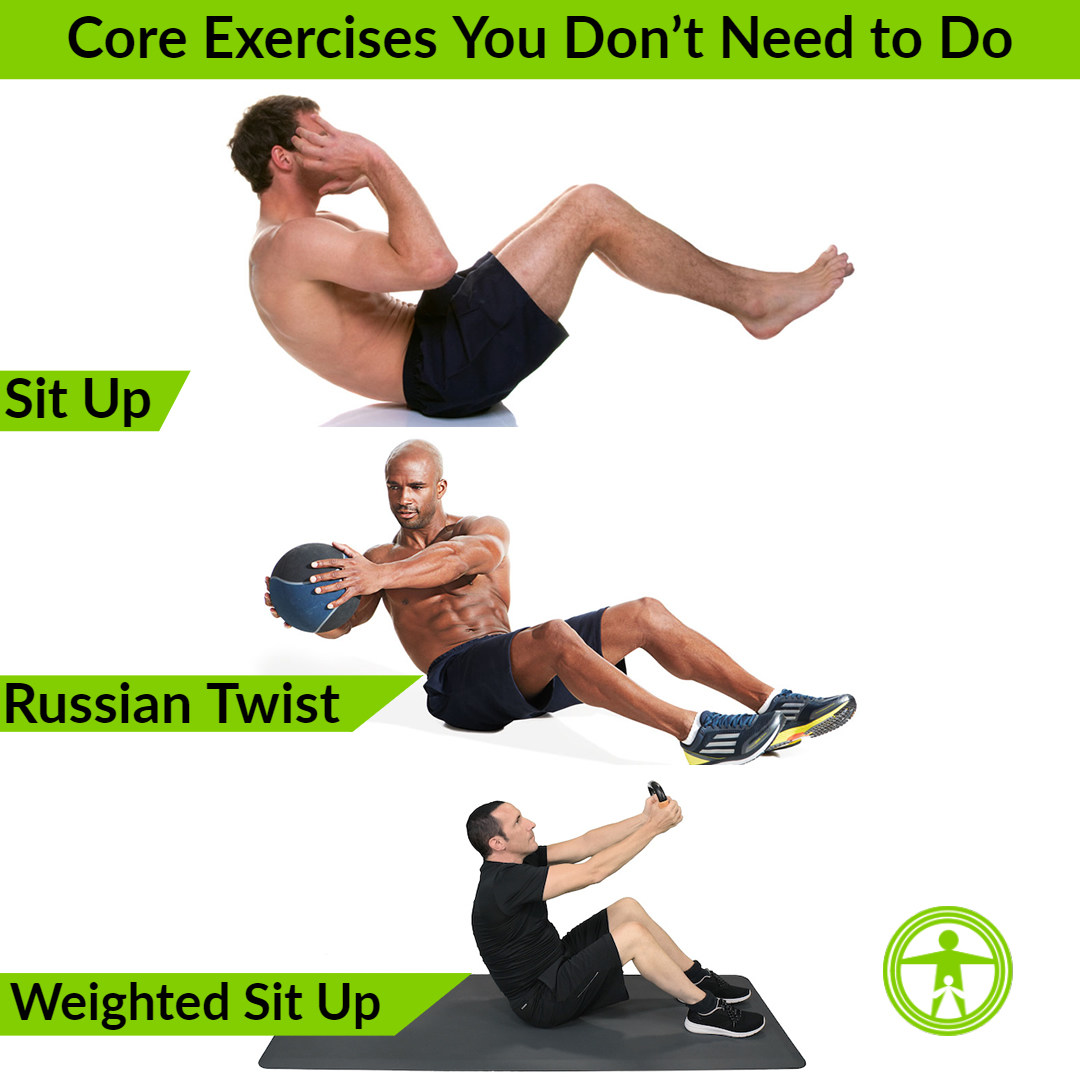The Hierarchy of Human Movement
Before you can understand why I'm not a fan of the following movements, you need to understand the hierarchy of human movement.
I almost have to stop myself from going to a fitness center at the beginning of the year because of “crash exercises” that absolutely cause harm to most of the people doing them.
Crash exercise is when otherwise unhealthy or unfit people decide they want to get into better shape and go pedal-to-the-metal full try-hard from the couch to the bench.
This never ends well.
This is why I try to cover the Hierarchy of Human Movement with every new patient that walks into my office.
We all know that you have to learn how to crawl before you stand up and walk. The same is true with running, swimming, riding a bicycle, etc.
When it comes to physical fitness, there is no exception. There are certain functions and capabilities required to be able to perform a task properly.
And if you are someone who has not been working out the past few months, I absolutely guarantee that you've got some housecleaning to do prior to performing serious strength and/or conditioning.
If you have not earned the ability to get into certain positions or perform certain movements, you should absolutely think twice about strengthening them.
The Hierarchy of Human Movement goes something like this:
- Flexibility – passive range of motion
- Mobility – active range of motion
- Strength & Balance
- Work & Rest
In short, if you do not have normal flexibility or mobility established, you have no business strengthening the muscles surrounding the joints of those body parts.
This is just asking for problems.
Three Exercises You Should Stop Doing
After more than 15 years of sorting out bad backs, creaky hips, achy knees and hunched-postures, I’ve become pretty good at spotting problems.
First and foremost, the three common core exercises you should stop doing right now include:
- The Sit-Up
- Sit-Ups with a Twist (russian twists)
- Weighted Sit Ups
Just don't. I should also include leg-lifts (where you lay on your back and lift your leg up). Why are you doing this?
It always comes as a shock when I say sit-ups are probably the worst thing you can do for your back; but they are.
They are absolutely a spinal accident waiting to happen.
The other surprise is that if you really are after a flatter tummy or washboard abs, doing hundreds of sit-ups will actually make you look MORE pot-bellied than before and even contributes to hunched posture!
In a 2011 US trial, one group did daily abdominal exercises while a control group did none.
After six weeks, the sit-ups made no difference to waist size or the amount of stomach fat.
Many people think doing loads of sit-ups burns stomach fat but the body just doesn’t work like that.
Why Sit Ups Gets a Thumbs Down!
The sit-up is considered a gold standard of fitness.
I consider it a gold standard for injury and the development of back pain.
Lying on your back, legs slightly bent, you pull yourself up, body trembling and hands cupped tightly around your ears. The focus is drawing the whole body up using the stomach muscles. Or, there's the variation (which is a better way to do it, but still somewhat costly) called the crunch, which involves raising the body up half way.
But the truth is it’s damaging to do sit-ups at the expense of exercises that target all the muscles surrounding the abdomen, or your core.
In 2015, the US Army ditched sit-ups as part of its notoriously intense training program – after research found they were responsible for 56 per cent of soldiers’ injuries.
The Navy Times, a magazine which covers the US Navy, is now calling for sit-ups to be banned completely because they're “outdated” and associated with a key cause of lower back injuries.
Why Are Sit Ups So Bad?
Biomechanically speaking, they go against the normal position of the spine.
Basically sit-ups push the curved spine against the floor and employ the psoas, or hip flexor, muscles running from the front of thighs to the lumbar spine in the lower back.
When these muscles are too tight they can pull the lumbar spine forward and the pelvis into a backward rotation, giving you a twisted pelvis.
When these muscles become tight, they cause postures and movements that contribute to pain.
It gets worse.
Stuart McGill, professor of spine biomechanics at the University of Waterloo, Canada, studied pig cadavers by flexing and extending their spines in a way that someone does sit-ups.
He found the discs in the spine – those shock absorbers that help to protect you – became damaged and even herniated.
But, “I Want Abs!”
I’m not sure where our abdominal fixation came from. It has to go back as far as 400 BC because we've got plenty of ripped Greek statues.
And I'm sure it's also largely fueled by anything else in our current landscape… marketing.
You've been sold on the idea that “Six-Packs” are beautiful. But do you even know what our abs (rectus-abdominnus) are for?
Let’s explore the purpose of abs first before we discuss how to properly train them.
The abdominal muscles – or “core” muscles – wrap around your midsection and serve 3 primary functions:
- Protect your internal organs
- Provide postural support
- Assist with breathing
The second part of “having abs” is simply being able to see those abdominal muscles.
When people say “I want abs” they’re typically not saying: “I would like better posture and to exhale more efficiently”.
Not all.
People really “wanting abs” because being able to show off chiseled stomach muscles has somehow become sexy, or beautiful.
Can you see someone’s “abs” and yet these people are completely unhealthy or lack a strong core? Yes or Yes?
Can someone have a very healthy spine and core without being able to see “abs”? Yes ore Yes?
Either way, if you want to train your abs because you're adamant about seeing them, here's what I suggest:
- Front planks
- Side planks
- Almost every kettlebell exercise that requires stabilizing the trunk, e.g. turkish-getups.
- Almost every large, heavy, compound movement (squats, deadlifts, press and pulls)
- High Intensive Interval Training (abs are worked when you're breathing heavy!)
Final Thoughts
Humans are Amazing.
We can do amazing things and yes… we can do hundreds to thousands of sit-ups.
But that doesn't mean it's healthy.
If you want to make your “core” stronger, train it to do what you functionally want it to do, which is transfer power, not create it.
I get that any time we challenge pre-conceived notions or ways that we have been doing things for ever, it’s challenging.
This is something that I come across quite a bit in healthcare.
For many people, To change, means we are admitting we are wrong. That's hard.
I think of it like this: “If I don’t change, I am not learning and probably missing the bigger picture.”
Doctors used to think that bloodletting was a great way to pull disease out of someone's body.
Doctors also used to drill holes into peoples heads to relieve pressure from their headaches.
Doctors used to recommend Camel Cigarettes, because you know… they were healthier than other brands?
Doctors used to prescribe heroin to kids for their coughs?
Wouldn’t it be silly if we still did all the above knowing what we know now?
As we learn, we should change.





